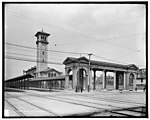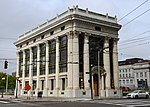Graphic Arts Building (Dayton, Ohio)
1924 establishments in OhioBuildings and structures in Dayton, OhioCommercial buildings completed in 1924Commercial buildings on the National Register of Historic Places in OhioDefunct book publishing companies of the United States ... and 2 more
National Register of Historic Places in Montgomery County, OhioUnited Church of Christ in Ohio

The Graphic Arts Building is a historic commercial building on the edge of downtown Dayton, Ohio, United States. Built in the 1920s, it long housed the publishing house of a Protestant denomination, and it has been named a historic site.
Excerpt from the Wikipedia article Graphic Arts Building (Dayton, Ohio) (License: CC BY-SA 3.0, Authors, Images).Graphic Arts Building (Dayton, Ohio)
Court Street, Dayton
Geographical coordinates (GPS) Address Nearby Places Show on map
Geographical coordinates (GPS)
| Latitude | Longitude |
|---|---|
| N 39.755833333333 ° | E -84.193055555556 ° |
Address
Court Street 117
45402 Dayton
Ohio, United States
Open on Google Maps









